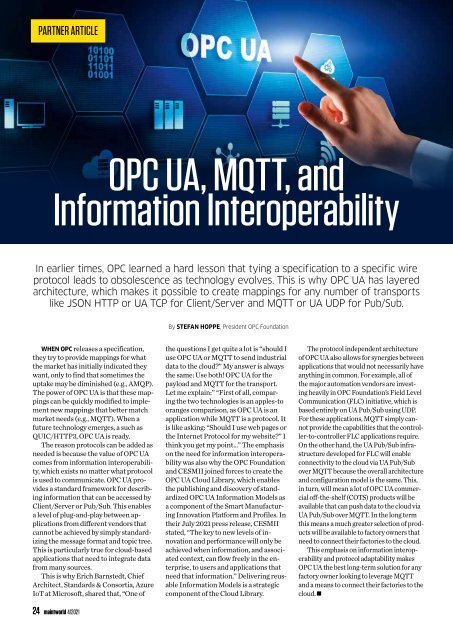Maintworld Magazine 4/2021
- maintenance & asset management
- maintenance & asset management
- No tags were found...
Create successful ePaper yourself
Turn your PDF publications into a flip-book with our unique Google optimized e-Paper software.
PARTNER ARTICLE<br />
OPC UA, MQTT, and<br />
Information Interoperability<br />
In earlier times, OPC learned a hard lesson that tying a specification to a specific wire<br />
protocol leads to obsolescence as technology evolves. This is why OPC UA has layered<br />
architecture, which makes it possible to create mappings for any number of transports<br />
like JSON HTTP or UA TCP for Client/Server and MQTT or UA UDP for Pub/Sub.<br />
By STEFAN HOPPE, President OPC Foundation<br />
WHEN OPC releases a specification,<br />
they try to provide mappings for what<br />
the market has initially indicated they<br />
want, only to find that sometimes the<br />
uptake may be diminished (e.g., AMQP).<br />
The power of OPC UA is that these mappings<br />
can be quickly modified to implement<br />
new mappings that better match<br />
market needs (e.g., MQTT). When a<br />
future technology emerges, a such as<br />
QUIC/HTTP3, OPC UA is ready.<br />
The reason protocols can be added as<br />
needed is because the value of OPC UA<br />
comes from information interoperability,<br />
which exists no matter what protocol<br />
is used to communicate. OPC UA provides<br />
a standard framework for describing<br />
information that can be accessed by<br />
Client/Server or Pub/Sub. This enables<br />
a level of plug-and-play between applications<br />
from different vendors that<br />
cannot be achieved by simply standardizing<br />
the message format and topic tree.<br />
This is particularly true for cloud-based<br />
applications that need to integrate data<br />
from many sources.<br />
This is why Erich Barnstedt, Chief<br />
Architect, Standards & Consortia, Azure<br />
IoT at Microsoft, shared that, “One of<br />
24 maintworld 4/<strong>2021</strong><br />
the questions I get quite a lot is “should I<br />
use OPC UA or MQTT to send industrial<br />
data to the cloud?” My answer is always<br />
the same: Use both! OPC UA for the<br />
payload and MQTT for the transport.<br />
Let me explain:” “First of all, comparing<br />
the two technologies is an apples-to<br />
oranges comparison, as OPC UA is an<br />
application while MQTT is a protocol. It<br />
is like asking: “Should I use web pages or<br />
the Internet Protocol for my website?” I<br />
think you get my point...” The emphasis<br />
on the need for information interoperability<br />
was also why the OPC Foundation<br />
and CESMII joined forces to create the<br />
OPC UA Cloud Library, which enables<br />
the publishing and discovery of standardized<br />
OPC UA Information Models as<br />
a component of the Smart Manufacturing<br />
Innovation Platform and Profiles. In<br />
their July <strong>2021</strong> press release, CESMII<br />
stated, “The key to new levels of innovation<br />
and performance will only be<br />
achieved when information, and associated<br />
context, can flow freely in the enterprise,<br />
to users and applications that<br />
need that information.” Delivering reusable<br />
Information Models is a strategic<br />
component of the Cloud Library.<br />
The protocol independent architecture<br />
of OPC UA also allows for synergies between<br />
applications that would not necessarily have<br />
anything in common. For example, all of<br />
the major automation vendors are investing<br />
heavily in OPC Foundation’s Field Level<br />
Communication (FLC) initiative, which is<br />
based entirely on UA Pub/Sub using UDP.<br />
For these applications, MQTT simply cannot<br />
provide the capabilities that the controller-to-controller<br />
FLC applications require.<br />
On the other hand, the UA Pub/Sub infrastructure<br />
developed for FLC will enable<br />
connectivity to the cloud via UA Pub/Sub<br />
over MQTT because the overall architecture<br />
and configuration model is the same. This,<br />
in turn, will mean a lot of OPC UA commercial<br />
off-the-shelf (COTS) products will be<br />
available that can push data to the cloud via<br />
UA Pub/Sub over MQTT. In the long term<br />
this means a much greater selection of products<br />
will be available to factory owners that<br />
need to connect their factories to the cloud.<br />
This emphasis on information interoperability<br />
and protocol adaptability makes<br />
OPC UA the best long-term solution for any<br />
factory owner looking to leverage MQTT<br />
and a means to connect their factories to the<br />
cloud.

















